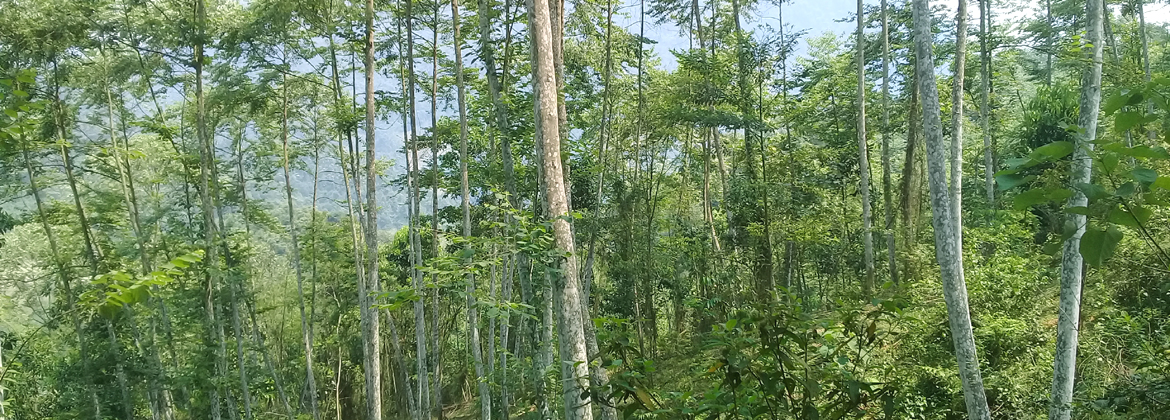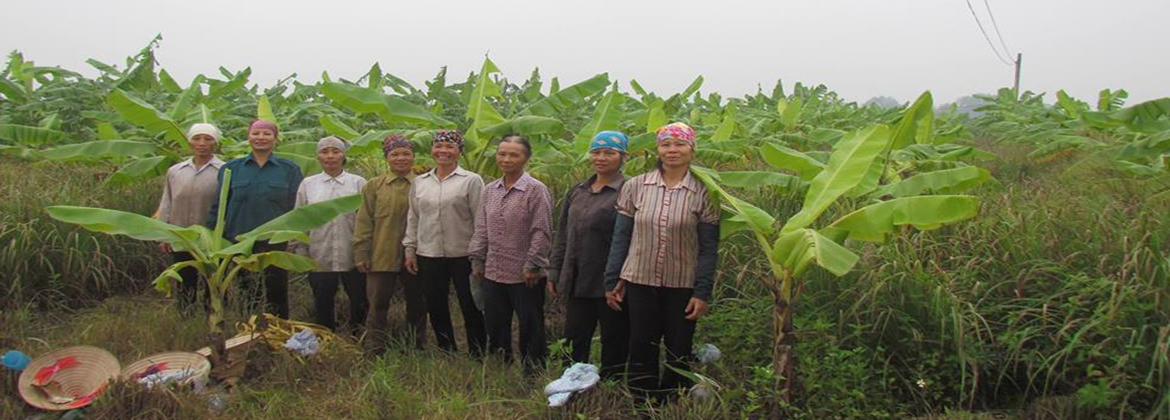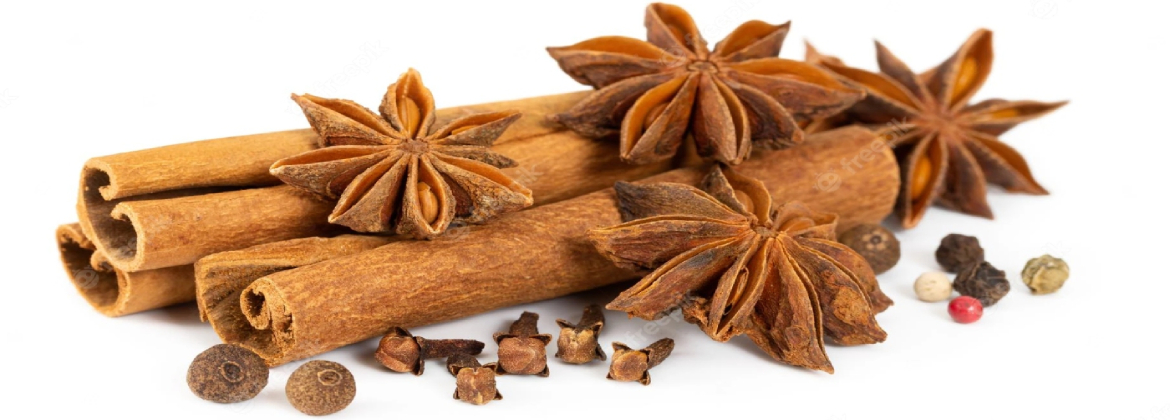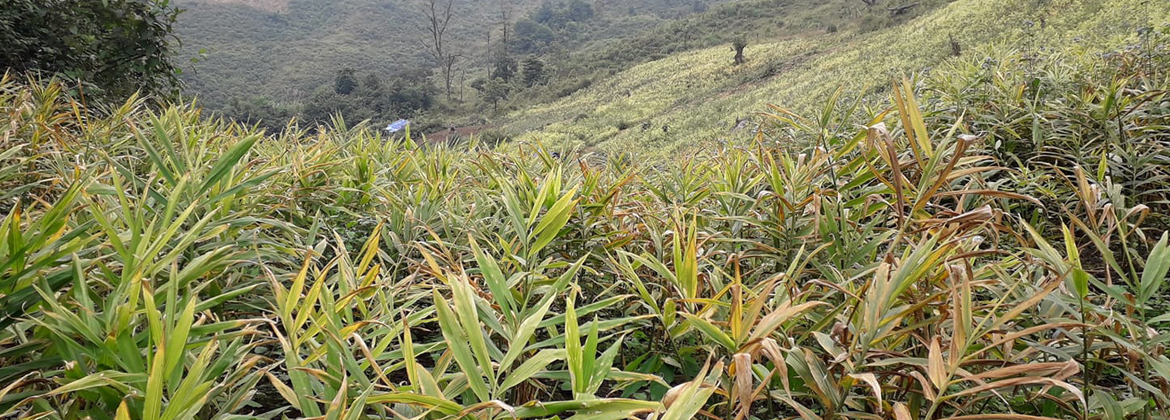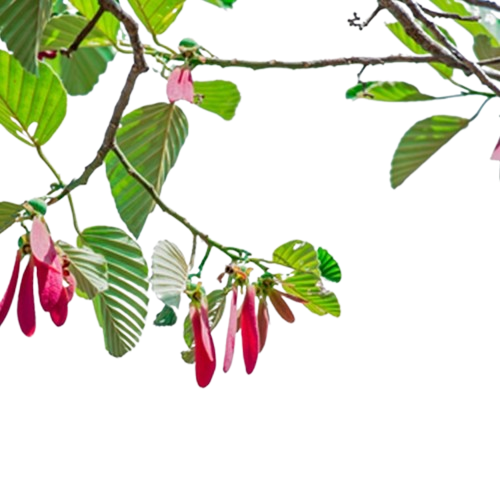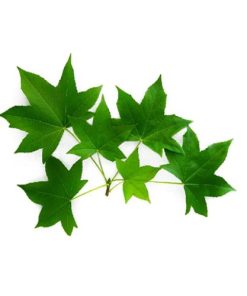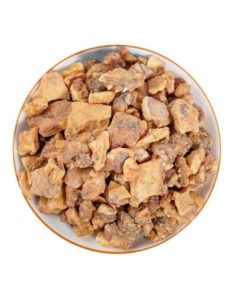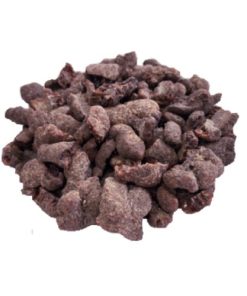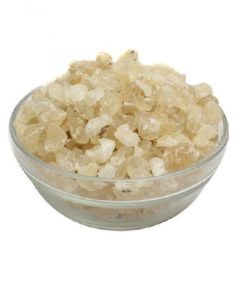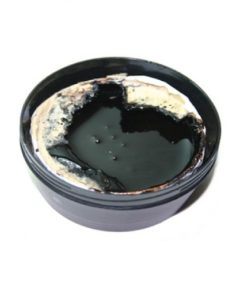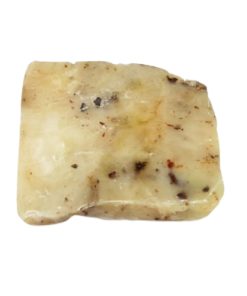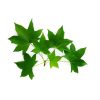Botanical Description
Botanical Description of Dipterocarpus turbinatus (Gurjum Balsam Tree)
A large evergreen tree, up to 40–45 m tall; bole straight, cylindrical, often clear for 20–25 m, up to 2.5 m in diameter; bark dark grey to brown, rough, exfoliating in irregular flakes, exuding a fragrant oleo-resin when wounded.
Leaves simple, alternate, ovate-oblong, 15–30 × 8–15 cm; base rounded or cordate, apex acute to shortly acuminate; upper surface glabrous, dark green, lower surface pale, densely pubescent, with prominent lateral nerves; petiole stout, 2–5 cm long.
Inflorescences axillary or terminal panicles, many-flowered; flowers bisexual, large, pendulous, and fragrant; sepals 5, lanceolate, persistent; petals 5, cream to yellowish-white, wrinkled, imbricate; stamens numerous; ovary superior, 3-celled, with long slender style. Flowering occurs from February to April.
Fruit a turbinate nut, 2.5–3.5 cm long, enclosed by the persistent calyx; two lobes of the calyx develop into long wings up to 15 cm, aiding dispersal by wind. Fruits ripen from May to June.
Wood heavy, reddish-brown, strong and durable, widely used in construction, plywood, and boat-building. The tree yields a brown aromatic balsam resin, known as Gujrum balsam or Gurjun oil.
Distribution and traditional uses:
Native to Southeast Asia, including Vietnam, where it grows naturally in evergreen forests of the central and southern regions. In Vietnam, local people have a long tradition of tapping Gujrum trees for resin. The balsam is collected and used in village industries for preparing incense, making traditional paints and varnishes, and occasionally in folk medicine. It also has applications in perfumery and waterproofing materials.
How to produce Gurjum resin
The production of Gurjum resin begins with the selection of mature trees, usually those more than thirty years old, since only large, healthy trees yield resin in good quantity. A cavity is cut into the trunk, about one to one and a half meters above the ground. In traditional practice, the inside of this cavity is burned or charred with fire, which stimulates the flow of resin. After the tapping, the oleo-resin gradually exudes from the wood and collects inside the cavity.
After a few days, the accumulated resin is scooped out or drained into containers. This process can be repeated every two to three weeks during the tapping season, and one tree may yield several liters of resin in a year. However, careful tapping is important, because excessive cutting or frequent tapping can weaken the tree and reduce the quality of the timber.
The resin obtained is thick, sticky, and brown with a strong aromatic odor. In some cases, it is distilled to separate Gujrun oil, which is used in perfumery and medicine. The remaining balsam is widely employed in village industries. In Vietnam, local people collect Gujrum resin to prepare incense, make traditional paints and varnishes, and waterproof boats and houses. This practice has been maintained as a traditional livelihood in many rural areas, linking the tree closely with both the economy and culture of local communities.
Gurjum Resin Specification
Appearance
Semi-solid or viscous liquid resin
Color: dark brown to pale brown, sometimes greenish-brown
Odor: mild, balsamic, slightly woody-aromatic
Taste: bitter, resinous
Chemical Composition
Contains resin acids (Dipterocarpol, Gurjunene, Dipterocarpolic acid)
Essential oil fraction: sesquiterpenes such as α-gurjunene, β-caryophyllene, alloaromadendrene, and selinene
Non-volatile portion: resins and phenolic compounds
Essential oil content: about 20%
Certificate of Analysis


CERTIFICATE OF ANALYSIS
No: 05/ 2025/ RAI
Product name
|
Gurjum Balsam Resin
|
Botanical Source
|
Dipterocarpus turbinatus
|
Manufacturing date
|
05/2025
|
Expiry date
|
05/2028
|
Origin
|
Vietnam
|
Batch No.
|
RAI0525
|
Cas No.
|
8030-55-5
|
FEMA
|
2133
|
No
|
Specifications
|
Standards
|
Results
|
01
|
Appearance
|
Semi-solid or viscous liquid resin
|
Complies
|
02
|
Colour
|
Dark brown to pale brown, sometimes greenish-brown
|
Complies
|
03
|
Odour
|
Characteristic odour of balsamic, slightly woody-aromatic
|
Complies
|
04
|
Solubility
|
Soluble in alcohol & Insoluble in water
|
Complies
|
05
|
Chemical composition
|
Dipterocarpol, Gurjunene, Dipterocarpolic acid
|
Complies
|
06
|
Conclusion
|
Comply all of the standards for Gurjun Balsam Resin.
|
Storage: Store in airtight containers in cool & dry place away from light & heat.
Caution: Possible skin sensitivity. Keep out of reach of children. If you are pregnant, nursing, or under a doctor’s care, consult your physician. Avoid contact with eyes, inner ears, and sensitive areas.
MSDS

MATERIAL SAFETY DATA SHEET
(according to Regulation (EU) No. 1907/2006)
Product name: Gurjum Balsam Resin
Number: RAI0525
1. IDENTIFICATION OF SUBSTANCE/PREPARATION & COMPANY.
Product name: Gurjum Balsam Resin
Manufacturer/Supplier: Vietnam Essential Oil., JSC
Add: Bai Dai Village, Tien Xuan Commune, Ha Noi City, Vietnam
Emergency telephone: +84 903561868
Emergency Contact: Mr. Peter Tron
2. COMPOSITION / INFORMATION ON INGREDIENTS.
Definition/Botanical Origin: Definition: Gurjum Balsam Resinoid obtained by solvent extract from the gum of the Dipterocarpus turbinatus tree original Vietnam.
Composition: Gurjum Balsam Resinoid 100% pure & natural
CAS No: 8030-55-5
INCI Name: Dipterocarpus turbinatus Resin
3. HAZARDS IDENTIFICATION:
This product is not hazardous. Not dangerous for the environment.
H304 May be fatal if swallowed and enters airways
H315 Causes skin irritation
H317 May cause an allergic skin reaction
H319 Causes serious eye irritation
4. FIRST-AID MEASURES:
Inhalation: Remove from exposure site to fresh air. Keep at rest. Obtain medical attention.
Eye contact: Rinse immediately with plenty of water for at least 15 mins. Contact a doctor if symptoms persist.
Skin contact: Remove contaminated clothes. Wash thoroughly with soap & water, flush with plenty of water. If irritation persists, seek medical advice.
Ingestion: Rinse mouth out with water. Seek medical advice immediately.
Other: When assessing action take Risk & Safety Phrases into account (Section 15)
5. FIRE FIGHTING MEASURES.
Extinguishing media Use CO2, Dry Powder or Foam type Extinguishers, spraying extinguishing media to base of flames. Do not use direct water jet on burning material.
Special measures: Avoid vapour inhalation. Keep away from sources of ignition. Do not smoke. Wear positive pressure self-contained breathing apparatus & protective clothing.
Extinguishing procedures: Closed containers may build up pressure when exposed to heat and should be cooled with water spray.
6. ACCIDENTAL RELEASE MEASURES.
Personal precautions: Avoid inhalation & direct contact with skin & eyes. Use individual protective equipment (safety glasses, waterproof-boots, suitable protective clothing) in case of major spillages.
Environment precautions: Keep away from drains, soils, surface & groundwaters.
Cleaning up methods Remove all potential ignition sources. Contain spilled material. Cover for spillages: with an inert or non-combustible inorganic absorbent material, sweep up and remove to an approved disposal container. Observe state, federal & local disposal regulations.
7. HANDLING & STORAGE.
Precautions in handling: Apply good manufacturing practice & industrial hygiene practices, ensuring proper ventilation. Observe good personal hygiene, and do not eat, drink or smoke whilst handling.
Storage conditions: Store in tightly closed original container, in a cool, dry & ventilated area away from heat sources & protected from light. Keep air contact to a minimum.
Fire protection: Keep away from ignition sources & naked flames. Take precautions to avoid static discharges in working area.
8. EXPOSURE CONTROLS/PERSONAL PROTECTION.
Respiratory protection: Avoid breathing product vapour. Apply local ventilation where possible.
Ventilation: Ensure good ventilation of working area.
Hand protection: Avoid all skin contact. Use chemically resistant gloves if required.
Eye protection: Use safety glasses.
Work/Hygiene practices: Wash hands with soap & water after handling.
9. PHYSICAL & CHEMICAL PROPERTIES.
Appearance: Semi-solid or viscous liquid resin
Colour: dark brown to pale brown, sometimes greenish-brown
Odour: Sweet, Balsam
Specific gravity at 20℃: not available
Refractive Index at 20℃: not available
Optical rotation at at 20℃: not available
Main components: Dipterocarpol, Gurjunene, Dipterocarpolic acid
Solubility: Insoluble in water./ Solubility in alcohol, solvents
10. STABILITY & REACTIVITY.
Reactivity: It presents no significant reactivity hazards, by itself or in contact with water. Avoid contact with strong acids, alkali or oxidising agents.
Decomposition: Liable to cause smoke & acrid fumes during combustion: carbon monoxide, carbon dioxide & other non-identified organic compounds may be formed.
11. TOXICOLOGICAL INFORMATION.
According to current information, not classed as hazardous to health in normal industrial use.
12. ECOLOGICAL INFORMATION.
Biodegradability: Data not available
Precautions: Prevent surface contamination of soil, ground & surface water.
13. DISPOSAL CONSIDERATIONS.
Avoid disposing to drainage systems and into the environment. Seek expert advice.
14. TRANSPORT REGULATIONS.
Shipping by road (ADR/RID): This product is not considered as dangerous goods
Shipping by air (IATA): This product is not considered as dangerous goods
Shipping by sea (IMDG): This product is not considered as dangerous goods
UN number: not regulated
UN proper shipping name: not regulated
Transportation hazard class: not regulated
Label: Gurjum Balsam Oil
15. REGULATORY INFORMATION. According to Directive 88/379/EEC
Hazards: Harmful
Symbols: n/a
Risk Phrases: Harmful if swallowed
Safety Phrases: If swallowed seek medical advice immediately and show the container / label
16. OTHER INFORMATION.
Cosmetics Directive – 7th Amendment – Not Restricted
Check maximum usage levels for skin care products.
PACKAGING:
Type
|
Suitability
|
Glass
|
Yes
|
Lacquer lined steel/tin
|
Yes
|
Aluminum
|
Yes
|
HPPE
|
Yes
|
SHELF LIFE:
Best before of 36 months from the date of manufacturing.
Q.C. REQUIREMENTS.
In-line with general product specification. Always satisfy suitability for specific application.
The data provided in this material safety data sheet is meant to represent typical data/analysis for this product and is correct to the best of our knowledge. The data was obtained from current and reliable sources, but is supplied without warranty, expressed or implied, regarding its’ correctness or accuracy. It is the user’s responsibility to determine safe conditions for the use of this product, and to assume liability for loss, injury, damage or expense arising from improper use of this product. The information provided does not constitute a contract to supply to any specification, or for any given application, and buyers should seek to verify their requirements and product use.
GC/MS


CERTIFICATE OF ANALYSIS
No: 05/ 2025/ RAI
Product name
|
Gurjum Balsam Resin
|
Botanical Source
|
Dipterocarpus turbinatus
|
Manufacturing date
|
05/2025
|
Expiry date
|
05/2028
|
Origin
|
Vietnam
|
Batch No.
|
RAI0525
|
Cas No.
|
8030-55-5
|
FEMA
|
2133
|
No
|
Specifications
|
Standards
|
Results
|
01
|
Appearance
|
Semi-solid or viscous liquid resin
|
Complies
|
02
|
Colour
|
Dark brown to pale brown, sometimes greenish-brown
|
Complies
|
03
|
Odour
|
Characteristic odour of balsamic, slightly woody-aromatic
|
Complies
|
04
|
Solubility
|
Soluble in alcohol & Insoluble in water
|
Complies
|
05
|
Chemical composition
|
Dipterocarpol, Gurjunene, Dipterocarpolic acid
|
Complies
|
06
|
Conclusion
|
Comply all of the standards for Gurjun Balsam Resin.
|
Storage: Store in airtight containers in cool & dry place away from light & heat.
Caution: Possible skin sensitivity. Keep out of reach of children. If you are pregnant, nursing, or under a doctor’s care, consult your physician. Avoid contact with eyes, inner ears, and sensitive areas.


